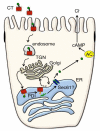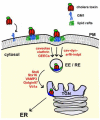Cholera toxin: an intracellular journey into the cytosol by way of the endoplasmic reticulum
- PMID: 22069586
- PMCID: PMC3153193
- DOI: 10.3390/toxins2030310
Cholera toxin: an intracellular journey into the cytosol by way of the endoplasmic reticulum
Abstract
Cholera toxin (CT), an AB(5)-subunit toxin, enters host cells by binding the ganglioside GM1 at the plasma membrane (PM) and travels retrograde through the trans-Golgi Network into the endoplasmic reticulum (ER). In the ER, a portion of CT, the enzymatic A1-chain, is unfolded by protein disulfide isomerase and retro-translocated to the cytosol by hijacking components of the ER associated degradation pathway for misfolded proteins. After crossing the ER membrane, the A1-chain refolds in the cytosol and escapes rapid degradation by the proteasome to induce disease by ADP-ribosylating the large G-protein Gs and activating adenylyl cyclase. Here, we review the mechanisms of toxin trafficking by GM1 and retro-translocation of the A1-chain to the cytosol.
Keywords: ERAD; cholera toxin; lipid rafts; retro-translocation; retrograde pathway.
Figures




References
Publication types
MeSH terms
Substances
LinkOut - more resources
Full Text Sources
Other Literature Sources

